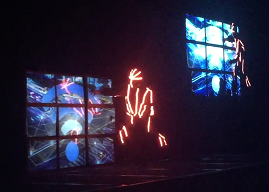
If there was one takeaway from Monday’s general session at Omnitracs Outlook 2017, it would be that the future of transportation is already upon us — whether we’re talking about innovation or a new regulatory landscape.
The session opened with black and white footage from a 1940s instructional video on truck driving as a career, reminding us of how far we’ve already come. A film burn effect transitioned from vintage trucking to the opening entertainment act, which can be best described as a futuristic dance performance. A performance with highly coordinated talent holding video screens to give a visual representation of trucking’s past and future. Wait, what? You’d have to be there to experience it, but the main message was this: disrupters such as IoT, autonomous vehicles, wearables, and drones are already here and reshaping the industry as we know it. And Omnitracs is here to provide innovative and efficient solutions for our customers.
What’s Already Changed
Omnitracs CEO John Graham, who appeared to emerge through the television screens, started off by saying that the past 24 months have been all about looking forward. Graham gave examples such as the passage of the ELD Mandate, Freightliner’s SuperTruck, and Otto’s autonomous Budweiser delivery.
Graham spoke about autonomous trucks, noting that while many say it will never happen, a lot is already in front of us. The government is authorizing this technology out in the market and platooning technology is already being tested.
Graham also spoke about how wearables will monitor drivers in a way that helps them be safer and more efficient. He went on to cover drones — “the hottest Christmas gift with the highest return rate” after all the living room crashes. We were reminded that it’s not just Amazon — DHL is delivering with drones and Marine Corps are using drones to look at resupplying troops. Driven by consumers and demand, Graham said, drones can add efficiency and lower delivery costs — providing about 80% savings in last mile shipping.
Continuing on futuristic trends, Graham talked about how sensors and IoT are “creating a smart environment around the truck” and talking about fog notes, (‘micro clouds’) around vehicles. He closed by giving the Omnitracs 2025 vision, explaining that Omnitracs is not only thinking about “here and now,” but also thinking many years ahead in this fast and accelerating environment.
Trucking Needs to Take a Seat
Following Graham, Chris Spear, President & CEO of the American Trucking Associations (ATA) took the stage. While Spear’s main focus was not about futuristic trends, he did continue on with the theme of how far the trucking industry has come and how rapidly it is changing. Spear first noted that we — the transportation industry — are the pioneers of our own future and we have an opportunity to help map a safer and more efficient industry for ourselves. Taking what some attendees thought to be a surprising turn, Spear dove right in to address the current U.S. administration and what this change is going to mean in the industry.
Spear sees the trillion-dollar infrastructure plan as a win for the industry, noting that we haven’t seen anything like it in a very long time.
How else might the Trump administration affect the industry? Spear brought up the ELD Mandate and how there’s a lot of talk in Washington and the media about the future of that regulation. He reminded us of the fact that this was passed by a Republican congress and stated that he anticipates it going into full effect come December 2017, making our industry “safer, environmentally friendly, and more productive.”
Autonomous vehicles came up in this general session once again. Spear stated that he sees that as something about 20-25 years away from now — but the framework for how that will feel is right now. A very important note from Spear on this was that trucking has to be a part of that. He stated that our industry cannot let the automotive industry decide. His advice? The trucking industry needs to take a seat or we will get behind. And Spear had some suggestions on how to go about doing this: meet with your Senate members regularly, and build a strong coalition to turn a “trucking story” into an important, economic story.
“Uncomfortable Trends” to Shape the Future of Transportation
Last on the main stage was futurist Jim Carroll, who offered his vision of what transportation could look like in the future. Like a flip phone looks to us now, today’s car dashboard will look old in three years, said Carroll.
What could change? Carroll predicts Siri in trucks, augmented reality screens with heads-up display, pavement technology embedded into the dashboard, and robotic handlers built into the truck infrastructure.
Carroll talked about the “innovation excuse” and how big ideas don’t happen when the fear of change exists. Said Carroll, there are three types of people: those who watch the future happen, those who make it happen, and those who said “wow, when did that happen?” His advice? “Think big, start small, and scale fast.”
